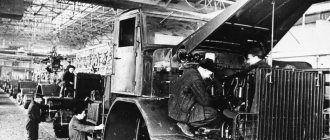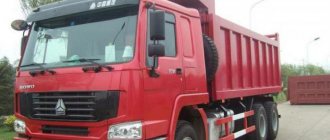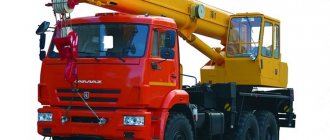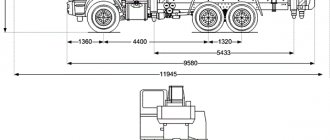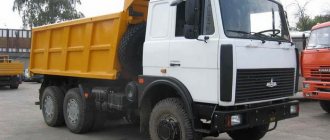MAZ dump trucks (20 tons) are only one of the directions in the wide range of trucks produced by the Minsk Automobile Plant. Users are offered modifications with different configurations of dump trucks, as well as a varied combination of transmissions and power units. However, vehicle series are divided depending on the characteristics of the engines. Let's look at the features and characteristics of these machines below.
Brand history
The Belarusian MAZ brand is known not only in the post-Soviet space, but also far beyond its borders. Trucks from this brand are distinguished by their original cabin with a company logo. The history of the plant, which produces MAZ dump trucks (20 tons), begins in the mid-40s of the last century. The first five cars came out in 1947, and a year later mass production was organized. By the beginning of 1952, the plant produced about 25 thousand cars, exceeding the plan by more than 60 percent.
It is worth noting that the history of the Minsk Automobile Plant is a collection of great successes and victories. At the Brussels specialized exhibition, the 50 series truck from Minsk manufacturers was awarded the highest category. Subsequently, it is planned to increase production without loss of quality indicators. The plant was once awarded the Orders of Lenin and the Revolution, as well as other honorary awards.
Evolution of the model
The appearance of the MAZ-525 dump truck changed several times during serial production. For example, the hood at the base was initially equal to the width of the cabin, but later they began to make it much narrower, saving metal on this. On MAZ-525 trucks in the first years of production, the radiator grille looked similar to the MAZ-200 grille. Then the semicircular radiator trim was replaced with a rectangular one.
The contact-oil air cleaner, which did not fit under the hood, was first installed on the left side of it, and then on the right. Real practical experience in dusty quarries pushed the manufacturer to install two filters on the machine at once.
Or: to ensure the safety of drivers and mechanics when servicing the diesel engine on this tall car, at first a guard was mounted on the sides of the hood, but then it was decided to abandon this decision. These small safety railings on the front fenders have been removed for good. The number of vertical stiffeners on the body changed: it varied from seven to six.
The chrome-plated figurine of a bison, which was initially placed on the hoods of MAZ-525 trucks, was later “divided into two parts”, and the emblem was attached in the form of bas-reliefs (stampings) to the sides of the hood. And then they began to install it “every once in a while” - not on every car. When the production of MAZ-525 cars was transferred from Minsk to Zhodino, to the Belarusian Automobile Plant, the bison from the hood completely disappeared. And in their place new inscriptions appeared - a series of letters “Belarusian Automobile Plant”.
MAZ dump trucks (20 tons)
This vehicle is the pride of the plant, produced under the index 5516. The first modification of this truck rolled off the assembly line in 1994. Then the car underwent a number of upgrades and improvements. Drivers and users note the ease of operation and unpretentiousness of the dump truck.
A truck of this type is equipped with a bucket body with a lifting capacity of 20 tons. The equipment based on this basis is aimed at transporting bulk cargo and building materials. The technical characteristics of the machine were optimally suited for various climatic regions.
Steering and braking systems of the MAZ-5516 truck
The steering system includes a steering gear with a built-in distributor, a column, a steering wheel, a power cylinder, a pump, an oil tank, and hoses.
The dump truck is equipped with four brake systems: service, parking, auxiliary and spare. There are also devices for connecting semi-trailer brakes with a 2-wire pneumatic drive.
The pneumatic type service braking system acts on all wheels through the brake drums. ABS - anti-lock braking system - is present in all versions. The parking and spare systems act on the brake elements of the middle and rear axles, which are actuated by means of brake chambers.
The parking system performs a number of backup functions and is used for braking in the event of possible failures of the service brake system. The auxiliary system is started by creating back pressure in the exhaust system. It is used for slight braking during long descents on mountain roads. Some MAZ-5516 cars are equipped with a 4-channel anti-lock braking system (ABS), produced by the Ekran production association, Belarus.
Description
The Maz dump truck (20 tons), the photo of which is shown above, was produced with two types of cabins. The extended version includes a sleeping bag. The updated high-tonnage vehicles were produced on the basis of agricultural dump trucks with an increased body height and the possibility of two-way unloading.
The car in question was produced for two decades. During this time, the series received a number of improvements and positive changes, while the evolution of the multi-ton truck continues to this day. The first modifications were equipped with diesel power units. Versions with the index 240 and 330 were available. More modern models received engines with a power of 330 horsepower.
The environmental friendliness of the engine of this truck corresponds to the Euro-3 category. As experimental versions, there are trucks with a 400-horsepower power unit from the German manufacturer. They are more expensive and are in demand not only here, but also abroad.
Suspension and chassis; cargo platform
The car frame is a welded spar frame, made of 36C beams, reinforced with overlays.
The rear axle, unlike the front axle, was rigidly attached to the frame, without any springs - the beam was bolted directly to the car frame. It was believed that no suspension could withstand the shock loads that occur when loading a dump truck with massive boulders.
In order to absorb the shock of the load loaded by the excavator, the bottom of the body was made double, made of powerful steel sheets with an oak gasket between them. Loads were transmitted directly to the frame through six rubber pads. Well, the main shock absorber was huge wheels with a tire diameter of 172 cm.
The front suspension is on two longitudinal semi-elliptic springs.
Cargo dump platform – metal, welded, bucket type. The floor is double, with a wooden layer between the sheets; in the rear, the floor is inclined (at an angle of 20 degrees); the front side is double. The front part of the platform is limited from lateral movements by two brackets.
The tipping mechanism of the dumping platform is hydraulic, with two telescopic cylinders. The tilt angle of the body is 65 degrees. To protect the cabin from impacts during loading, the platform had a protective visor in the front part.
Truck Features
The MAZ super dump truck (20 tons), equipped with a classic YaMZ engine, includes a mechanical transmission unit. Modern versions use a German manual transmission with nine modes. Some versions of the dump truck are supplied with a reinforced frame (the “spar-in-spar” variation). As users and experts note, in this case the price of the vehicle increases, which leads to a slight drop in demand.
The standard formula for the machines in question is 6*4. The maximum speed of the truck is 80 km/h. At the same time, fuel consumption is about 30 liters per “hundred”. Fuel tanks hold 350 liters.
Engine and transmission MAZ-525
Dump trucks of this model were equipped with twelve-cylinder tank diesel uncompressor engines D-12A, derated from 450 hp. up to 300 hp RPM – 1500 per minute. The minimum idle speed is 500, the maximum is 1700 rpm.
The working volume of this engine was 39 liters (38,880 cm3).
D-12 is a Soviet V-shaped 12-cylinder four-stroke diesel tank engine, water-cooled, 24-valve, with direct diesel fuel injection. The two cylinder blocks are arranged in a V-shape at an angle of 60°. Compression ratio – 14:1. Cylinder diameter – 150 mm. The piston stroke is 180 mm (left) and 186.7 mm (right).
A hydraulic coupling (fluid coupling) is mounted on the crankshaft flange of the MAZ-525 car engine.
A three-section gear oil pump was installed on the engine. It had three sections: two pumping and one pumping.
Air was sucked into each cylinder block through separate air ducts, through two inertial-type air cleaners.
The diesel engines of MAZ-525 cars were equipped with booster pumps of the BNK-12TS brand. Diesel fuel was supplied to the injectors by a twelve-plunger high-pressure fuel pump.
In front of the engine there is a radiator for the engine cooling system and a fan driven by the crankshaft through a V-belt drive.
On MAZ-525 vehicles there were two fuel tanks, connected to each other and installed behind the cab. Diesel fuel from the right tank was supplied through a pipeline to the fuel priming pump, which ensured a continuous supply of fuel.
MAZ-530, MAZ-525, MAZ-205
The D-12 engine traces its history back to the famous V-2 tank diesel engine, developed in the late 1930s at the Kharkov Locomotive Plant. This engine (in various modifications) was installed on the main Soviet tanks - BT-7, KV, IS and, of course, on the legendary “weapon of Victory” - T-34; for heavy artillery tractors "Voroshilovets".
Based on the V-2 engines, in the second half of the 1940s - early 1950s, lightweight diesel engines for various sectors of the national economy were created and put into mass production at Barnaultransmash - first six-cylinder D-6, and then 12-cylinder D -12. Both six- and twelve-cylinder diesel engines are widely used on river vessels. D-12 was also used on diesel locomotives, bulldozers and military engineering vehicles (on a tank chassis).
It is combined with a fluid coupling protecting the transmission and installed immediately behind it. The gearbox on the MAZ-525 is a mechanical four-way, with five forward gears and one reverse gear. The gearbox is made in a single unit with a clutch and is attached to the frame brackets through rubber shock absorbers.
MAZ dump truck (20 tons): technical characteristics of the vehicle
Below are the main technical parameters specific to this truck:
- Length/width/height – 7190/2500/3100 mm.
- Ground clearance (ground clearance) – 27 cm.
- Rear/front track – 1865/1970 mm.
- Wheelbase – 3850 mm.
- Weight – 13.5 tons.
- The volume of the MAZ dump truck body 20 tons is 10.5 cubic meters.
- The brake system is an auxiliary, parking and working unit.
- The nominal load capacity on a flat road is 30 tons.
- The body is working - tipper type.
Modifications
At the turn of the 1950s and 1960s, an attempt was made in Zhodino to create a MAZ-525A truck tractor, based on the main model, for working as a road train with a single-axle tipper semi-trailer of its own design, BelAZ-5271, with a load capacity of 45 tons of rock or soil. However, this development was considered unsuccessful, and the MAZ-525A tractor did not go into mass production. Only a semi-trailer from it was put into production in 1962, already with a completely new tractor model BelAZ-540A.
Just a year after the start of mass production of the MAZ-525 mining dump truck, the Minsk Automobile Plant produced the MAZ-E-525D truck tractor based on this truck. This vehicle was designed to work in conjunction with a 15 cc D-189 scraper. However, he could cope with it alone only when moving empty and when simply transporting cargo. When the body was filled, a pusher was added to the road train - the same MAZ-E-525D with ballast over the rear axle. The pusher worked not with one, but with several scrapers at once, so this type of work was quite effective.
A fully loaded tractor moved at a speed of 28 km/h. It had the following dimensions: 6730 x 3210 x 3400 mm, and a wheelbase of 4000 mm, which is 780 mm less than the dump truck on which it was based. Behind the cab of the MAZ-E-525D truck, a motor-driven winch with a traction force of up to 3500 kg was installed to control the scraper.
A new word in mechanical engineering was the trolley truck - an electric dump truck, created in 1954 by specialists from the Institute of Mining of the Academy of Sciences of the Ukrainian SSR, the Kharkov Trolleybus Depot and the Soyuznerud Trust. Earlier, in 1952, the designers had already “practised” in creating trolley carriers, making them on the chassis of the MAZ-205 and YaAZ-210E dump trucks. Two years later it was the turn of the 25-ton MAZ-525.
According to the project developers, the use of trolley-electric dump trucks should have significantly increased the operating efficiency of trucks of this “caliber”. The trolley vehicle on the chassis of the quarry MAZ-525 was equipped with two DK-202 trolleybus electric motors with a total power of 172 kW (234 hp), which were controlled by one controller and four contact panels of the TP-18 or TP-19 type. The electric motors also powered the power steering and the lifting device of the dump truck.
The supply of electrical energy from the power plant to the engines of trolley trucks was carried out in the same way as with conventional trolley buses: along the route of their work it was necessary to stretch the wires, which the electric dump trucks touched with two arcs mounted on the roof of their current collectors.
In 1964, NAMI (Research Automotive and Motor Institute) developed another experimental model of a trolley dump truck based on the MAZ-525, called DTU-25.
Also in 1959, based on the MAZ-525, 3 units of the MAZ-541 wheeled airfield tractor were produced.
Advantages
The advantages of the truck in question include the following points:
- High level of maintainability, cost-effectiveness.
- Easy to maintain and operate.
- Possibility of increasing the working life by using an additional trailer with side unloading.
- Relatively low price for this class of machines, along with the availability of spare parts.
- Powerful power unit in several variations.
- Decent exterior.
- Reliable and high-quality suspension.
User reviews about use
As reviews note, the MAZ dump truck (20 tons) performs well in use, even with ten years of mileage. This indicates high build quality and thoughtful design of the equipment. In addition, experts confirm that the machine in question has a high level of performance and reliability.
Despite all the transformations of the car, the ergonomics and comfort of the cabin have not received any significant improvements. The price of a vehicle largely depends on the condition and replacement of components and main units. Users note that MAZ dump trucks (20 tons) are primarily workhorses, focused on operation in the construction and business sectors. Constant improvement of the truck has ensured its popularity over the years.
MAZ-5551
The legendary time-tested dump truck began production in 1985. At that time, its maximum carrying capacity was only 8 tons, but several upgrades were able to correct this shortcoming. The last update took place after the advent of the 21st century. The car has a brand new cabin, under its hood there is a powerful modern engine that meets current environmental standards.
Specifications
- Engines from Cummins and YaMZ on different models have approximately the same power of 250 hp. and are capable of accelerating the vehicle up to 90 km/h
- 9-speed gearbox from YaMZ
- Power steering
- Fuel consumption 22 l per 100 km
- Fuel tank capacity 200 l
General characteristics
- The maximum load capacity is 10 tons for all modifications sold since 1998
- Gross weight with loading does not exceed 16.5 tons
- The height of the car is 2.925 m, so you should pass under three-meter bridges with caution
- Ground clearance does not exceed 28 cm
MAZ-5551 is a dump truck, so ease of unloading plays an important role for it. The cabin rises to 47 degrees in 15 seconds when fully loaded. It takes about 10 seconds to return to the starting position.
Cabin
The updated one has comfortable seats. The driver's side seat is sprung, but that's all the comfort you can expect. As if wanting to emphasize that the MAZ-5551 was created exclusively for work, the designers did not even include a radio in the basic package.
This spartan style is slightly compensated by the convenient tilting cockpit mechanism, which takes into account and corrects all the shortcomings of earlier modifications. Now the cabin tilts smoothly, providing free access to all other elements, and the location of the tilting mechanism under the radiator grille serves as an excellent safety system, because without opening the grille, it will be impossible to raise the cab.
Despite the presence of several shortcomings, the MAZ-5551 is still considered one of the best solutions of the plant, since it performs its functions properly for decades, regardless of the vagaries of the weather and the intensity of operation.
Flaws
Below are the main disadvantages that this dump truck has:
- Excessive suspension stiffness, poor ergonomics and cabin comfort are noted.
- The monotonous and unpresentable coloring is not very impressive.
- Engine operation is not always reliable.
Despite all these shortcomings, this truck was highly rated. The machine was created exclusively for work purposes and has proven its performance faithfully. A carrying capacity of 20 tons is not the limit for transporting goods. At low speeds and on flat surfaces, the car is capable of transporting up to 30 tons.
About the successor to MAZ-5516
Without stopping the production of the MAZ-5516 family, Minsk Automobile Three-axle construction dump trucks are releasing an updated analogue of the 5516 series - MAZ-6501. This car is already equipped with a new type of cabin, which was originally developed for Minsk highway vehicles.
Already in 2011, the number of those built exceeded the number of MAZ-5516 produced. But we are not talking about replacing the previous one with a new model in the segment of three-axle twenty-ton trucks. As long as there is stable demand on the market for MAZ-5516, they will continue to be produced.
Modernization
Since the truck in question is not highly maneuverable with a gear ratio of 7.24, the designers included some innovative implementations in subsequent releases. Among them:
- Improvement of the gear shift lever, which left much to be desired due to rigidity, uneven movement and retardation when shifting gears.
- The designers made a number of manipulations to improve the comfort and spaciousness of the working cabins.
- Now the driver has a better view thanks to the high seating position.
- The engine has been heated, making it easy to start at sub-zero temperatures.
- Increased insulation from noise and vibration.
- The seat is equipped with adjustment in several positions.
- Pneumatic shock absorbers have appeared, located under the chair, which reduce operator fatigue during prolonged work and movement over long distances.
The truck in question is equipped with an engine from the Yaroslavl plant (type - YaMZD-238D). Its power is 243 horsepower with a torque of 1225 Nm. Modern modifications use power units whose power reaches 400 horsepower. Their working life is longer, but the devices are more difficult to maintain and repair compared to their domestic counterparts.
